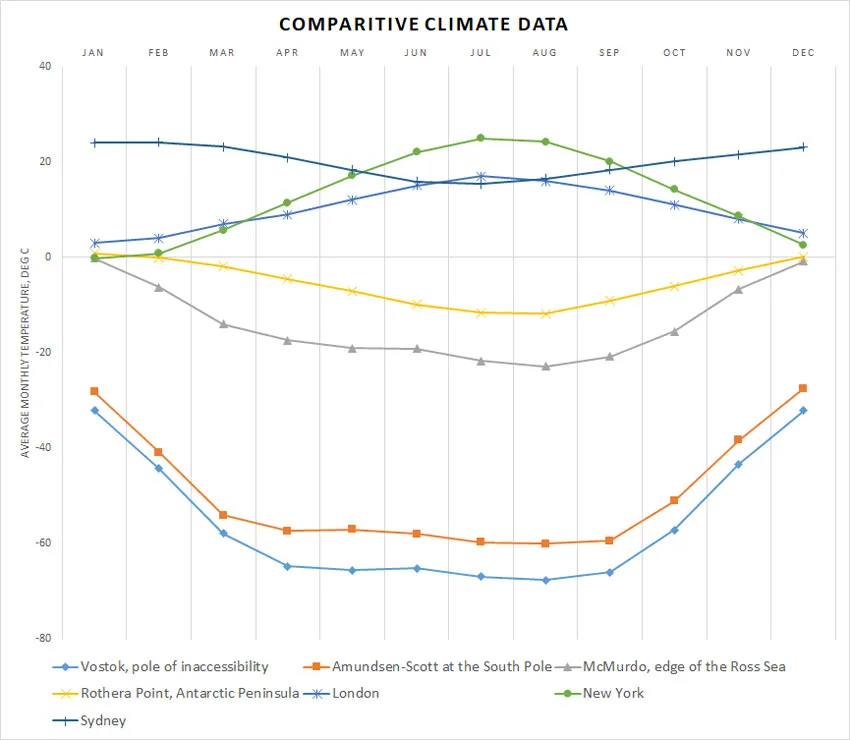Antarctica Climate Data and Climate Graphs
Comparison and overview average monthly temperature for four representative stations in Antarctica, and three centers of population on other continents

Vostok - 78.45°S - Continental High Plateau - Russian base at the Southern Geomagnetic Pole. It is close to the Pole of Inaccessibility, the point on the Antarctic continent that is the furthest from any other and so the most difficult or inaccessible place to get to. Consistently the coldest place on earth. Holder of the record for the lowest temperature ever recorded on the planet -89.2°C (-128.6°F) on July 21st 1983.
Amundsen-Scott - 90°S - Continental High Plateau - American base at the South Pole, named after Roald Amundsen and Robert Falcon Scott, the leaders of the first expeditions to reach the South Pole.
McMurdo - 78.88°S - Continental High Latitude Coast - American base on the edge of the Ross sea, far and away the largest base in Antarctica, more of a small town.
Rothera point - 67.56°S - Antarctic Peninsula - British base about half-way down the Antarctic Peninsula, most Northerly of the Antarctic bases represented here.
London - 55.55°N - Example of a Northern Hemisphere city, further North than New York so temperatures don't get so high. The warming effects of the Gulf Stream ensure that temperatures don't fall very low.
New York - 40.7°N - Northern Hemisphere city with a coastal climate.
Sydney - 33.7°S - Southern Hemisphere city with a coastal climate
Note how the seasonal changes in the shape of the graphs are the opposite way round for London and New York to the other places as these are in the Northern Hemisphere, whereas the others are in the southern hemisphere and so the seasons are reversed
The graph above and data below are the average monthly temperatures. These are good for comparison purposes but a bit misleading when imagining what the climate in a location is like. They even out the diurnal (daily) changes in temperature from day to night. It is nearly always warmer in daylight than at night time.
For example, even though the average London temperature for August is 16°C, the average maximum is 21°C and average minimum is 12°C, a few days before writing this page (10th Aug 2003) a temperature of 37.6°C was reached in London.
Likewise the average July temperature for Vostok is -66.9°C, but the lowest recorded was -89.2°C.
The data given here is simplified for the sake of clarity. It's very easy when quoting weather statistics to get rapidly overwhelmed with numbers.
Data for above graphs, mean monthly temperature in degrees Centigrade
| Jan | Feb | Mar | Apr | May | Jun | Jul | Aug | Sep | Oct | Nov | Dec | |
| Vostok, near pole of inaccessibility | -32.1 | -44.3 | -57.9 | -64.7 | -65.6 | -65.2 | -66.9 | -67.6 | -66 | -57.1 | -43.3 | -32.1 |
| Amundsen-Scott - South Pole | -28.2 | -40.9 | -54 | -57.3 | -57 | -58 | -59.7 | -60 | -59.4 | -51.1 | -38.3 | -27.5 |
| McMurdo, edge of the Ross Sea | -0.2 | -6.3 | -14 | -17.4 | -19 | -19.1 | -21.7 | -22.8 | -20.8 | -15.5 | -6.7 | -0.8 |
| Rothera Point, Antarctic Peninsula | 0.8 | -0.1 | -1.9 | -4.5 | -7.1 | -9.9 | -11.6 | -11.8 | -9.1 | -6.1 | -2.8 | 0.1 |
| London | 3 | 4 | 7 | 9 | 12 | 15 | 17 | 16 | 14 | 11 | 8 | 5 |
| New York | -0.2 | 0.8 | 5.7 | 11.4 | 17.1 | 22 | 24.9 | 24.2 | 20.1 | 14.2 | 8.7 | 2.6 |
| Sydney | 24 | 24.1 | 23.2 | 20.9 | 18.3 | 15.9 | 15.3 | 16.5 | 18.3 | 20.1 | 21.5 | 23.1 |
If you want to translate these figures into degrees Fahrenheit, the table can be copied and dropped into an Excel spreadsheet and this formula applied:
Temperature in degrees Fahrenheit = (Temperature in degrees centigrade x 1.8) + 32
F = 1.8*C + 32
